Related Research Articles

Kongens Lyngby is the seat and commercial centre of Lyngby-Taarbæk Municipality in the northern suburbs of Copenhagen, Denmark. Lyngby Hovedgade is a busy shopping street and the site of a branch of Magasin du Nord as well as Lyngby Storcenter. The district is also home to several major companies, including COWI A/S, Bang & Olufsen, ICEpower a/s and Microsoft. The Technical University of Denmark relocated to Lyngby from central Copenhagen in the 1970s. Lyngby station is located on the Hillerød radial of Copenhagen's S-train network.

Christiansborg Palace is a palace and government building on the islet of Slotsholmen in central Copenhagen, Denmark. It is the seat of the Danish Parliament, the Danish Prime Minister's Office, and the Supreme Court of Denmark. Also, several parts of the palace are used by the Danish monarch, including the Royal Reception Rooms, the Palace Chapel and the Royal Stables.

Johannes Wiedewelt, Danish neoclassical sculptor. He became a court sculptor, introducing neoclassical ideals to Denmark in the form of palace decorations, garden sculptures and artifacts and, especially, memorial monuments. He was undoubtedly the best known Danish sculptor before Bertel Thorvaldsen.
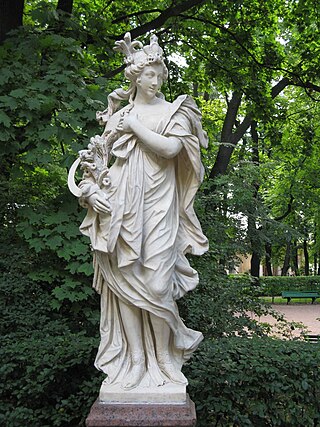
Thomas Quellinus, also known, especially in Denmark, as Thomas Qvellinus, was a Flemish baroque sculptor. He was born in Antwerp as a member of the well-known Quellinus family of artists active in 17th century Antwerp. He worked most of his career in Copenhagen, Denmark, where he operated a workshop. He is especially known for the production of grandiose and sumptuous memorial chapels, sepulchral monuments and epitaphs, which can be found in churches throughout Denmark and northern Germany's Schleswig-Holstein area. His chapels and monuments are dramatically composed, executed in rare, differently coloured types of marble and framed by monumental architectural components.
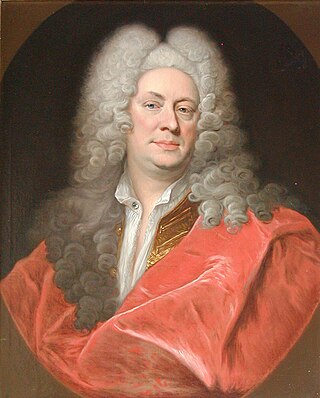
Hendrick Krock was a Danish history painter who, from 1706, was the court painter of Frederick IV as well as his successor Christian VI. Along with Benoit Le Coffre set the tone for history painting in Denmark during the 18th century-1720s, having been influenced by the Italian baroque painting he experienced during his travels. He also played a role in the eventual establishment of an Art Academy in Denmark.

Nicolas-Henri Jardin was a French architect. Born in St. Germain des Noyers, Seine-et-Marne, Jardin worked seventeen years in Denmark–Norway as an architect to the Danish royal court. He introduced neoclassicism to Denmark–Norway.
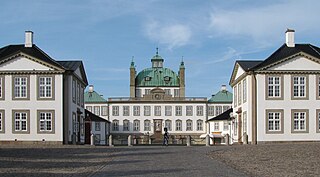
Fredensborg Palace is a palace located on the eastern shore of Lake Esrum in Fredensborg on the island of Zealand (Sjælland) in Denmark. It is the Danish royal family’s spring and autumn residence, and is often the site of important state visits and events in the royal family. It is the most used of the royal family’s residences.

The Church of Our Lady is the Lutheran cathedral of Copenhagen. It is situated on the Frue Plads public square in central Copenhagen, next to the historic main building of the University of Copenhagen.

St. Peter's Church is the parish church of the German-speaking community in Copenhagen, Denmark. It is situated at the corner of Nørregade and Sankt Peders Stræde in the city's Latin Quarter. Built as a single-nave church in the mid-15th century, it is the oldest building in central Copenhagen. It is also notable for its extensive complex of sepulchral chapels.
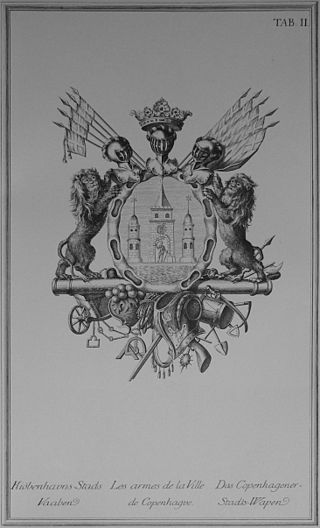
Den Danske Vitruvius is a richly illustrated 18th-century architectural work on Danish monumental buildings of the period, written by the Danish Baroque architect Lauritz de Thurah. It was commissioned by Christian VI in 1735 and published in two volumes between 1746 and 1749. The title refers to the Roman architect and engineer Vitruvius, who published De architectura in the 1st century AD, an authoritative treatise on the architecture of the time. The direct inspiration for de Thurah's Den Danske Vitruvius was Colen Campbell's Vitruvius Britannicus.
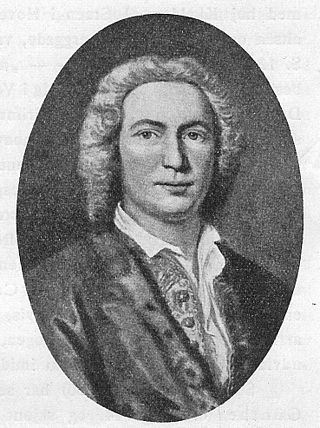
Simon Carl Stanley known in England as Charles Stanley was a Danish sculptor of English parentage.

Johan Conrad Ernst was a Danish architect and royal master builder. He was the son of Johan Adolf Ernst, a successful linen merchant who had immigrated from Nuremberg and had a luxurious residence on Amagertorv in Copenhagen.

Jacob Fortling was a German-Danish sculptor, architect and industrialist, described as one of the most industrious people in the Denmark of his day. He came to Denmark at age 18 and embarked on a successful career, first as a sculptor and later also as an architect. He was also engaged in the production of building materials, owning several quarries in Norway. Just outside Copenhagen, on Amager's east coast, he founded Kastrup Værk, a large industrial facility combining a lime plant, a brickyard and a pottery.
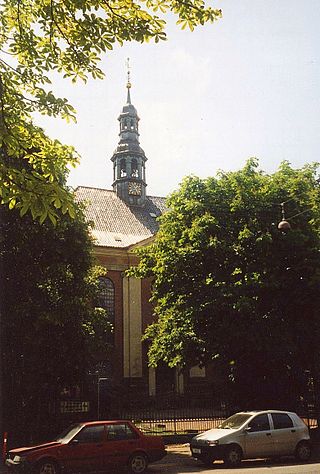
Reformed Church in Gothersgade, opposite Rosenborg Castle, is a church building used by the reformed congregations in Copenhagen, Denmark. Consecrated in 1689, the church was instigated by Queen Charlotte Amalie, consort of King Christian V, who was herself a German Calvinist. The church is noted for its fine Baroque interiors which date from 1730 when it was restored after being damaged in the Copenhagen Fire of 1728.

Johan Cornelius Krieger (1683–1755) was a Danish architect and landscape architect, who from the 1720s served as both the country's chief architect, and head of the royal gardens.

Ernst Brandenburger was a Danish master builder and entrepreneur who, through his collaboration with Christof Marselis and Wilhelm Friedrich von Platen (1667-1732), left his mark on Danish Baroque architecture during the early reign of King Frederick IV.

Carl Marcus Tuscher was a German-born Danish polymath: portrait painter, printmaker, architect, and decorator of the Baroque period.

Frederik Vilhelm Tvede was a Danish architect.
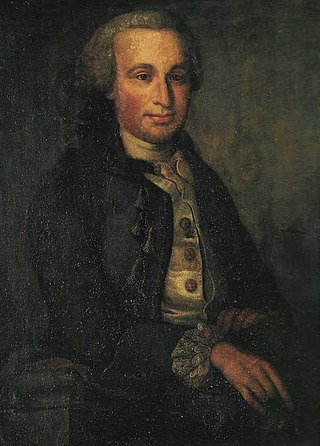
Johann Gottfried Grund was a German-Danish sculptor. He created the sculptures in Nordmandsdalen at Fredensborg Palace. The sculptures in Nordmandsdalen have been replaced by replicas while Grund's original works have been moved to Christian IV's Brewhouse in Copenhagen.
References
- 1 2 3 "Friedrich Ehbisch" (in Danish). Den Store Danske . Retrieved 16 November 2012.